Kinetics KINAIR Ecology Units (ECU Series) – Advanced Kitchen Exhaust Filtration Systems
Kinetics Ecology Units (ECU Series) are engineered to deliver clean, odor-free, and environmentally safe kitchen exhaust air for commercial and industrial kitchens. Designed for effective removal of grease, smoke, and odor particles, our KINAIR Ecology Units ensure compliance with indoor air quality standards while minimizing environmental impact.
These units integrate a multi-stage filtration system including Electrostatic Precipitator (ESP), Pre-filters (G4), Fine filters (F7), and optional Activated Carbon or EPA filters to efficiently capture contaminants. The ESP sectionionizes grease and smoke particles, drawing them to grounded collector plates where they are trapped and later washed off — ensuring consistent, long-term performance.
Built with double-skin aluminum structure, GI panels (0.8 mm inner & outer), and PUF/Rockwool insulation (50 mm), the unit provides high durability, sound attenuation, and thermal protection.
Key Features
-
Airflow Range: 500 – 30,000 CFM (up to 2 × 15,000 CFM)
-
Filtration Stages: ESP + G4 + F7 + Carbon Filter (configurable combinations)
-
Fan Options: DIDW / SISW (Standard, 400°C/2hr, or UL Listed)
-
Motor Options: IE2 / IE3 with Class F (Std.) / Class H (Optional) insulation
-
Optional Accessories: DPS, DPT, Pressure Gauge, Limit Switch, Marine Light, Sight Window, Ozone Generator
-
Construction: Double-skin aluminum profile with insulated GI panels
-
Base Frame: 30/50/100 mm GI, 2 mm thickness
Benefits
-
Removes grease, smoke, and odor for cleaner kitchen exhaust
-
Protects ducts, fans, and building exteriors from oil buildup
-
Enhances Indoor Air Quality (IAQ) and environmental safety
-
Ensures compliance with ASHRAE and local environmental regulations
-
Reduces fire hazards and maintenance frequency
-
Suitable for restaurants, hotels, central kitchens, and food production facilities
Applications
-
Commercial kitchens and food courts
-
Hotels, restaurants, and catering facilities
-
Centralized kitchen exhaust systems
-
Industrial cooking and food processing plants
Purify your kitchen air with Kinetics KINAIR Ecology Units — engineered for cleaner, safer, and more efficient exhaust systems.
📞 Contact us to discuss your project requirements.
🌐 Visit www.kineticsgroup.ae
















